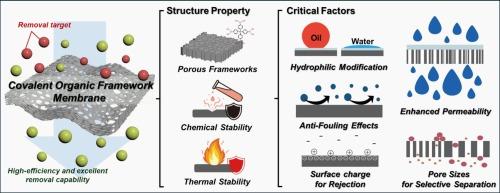Covalent organic framework membranes for wastewater treatment: structural design, interfacial modulation, and environmental applications
IF 9
1区 工程技术
Q1 ENGINEERING, CHEMICAL
引用次数: 0
Abstract
The contamination of water resources by persistent organic pollutants, such as polycyclic aromatic hydrocarbons and chlorinated solvents, and inorganic contaminants, including heavy metals like lead and mercury, poses substantial risks to human health and aquatic ecosystems. Conventional wastewater treatment technologies, including biological degradation, coagulation–flocculation, activated carbon adsorption, and advanced oxidation processes, often exhibit limited efficiency in removing low-concentration or recalcitrant pollutants under variable environmental conditions. Membrane-based separation technologies offer a promising alternative due to their energy efficiency, design flexibility, and selective removal capabilities. Among these, Covalent Organic Frameworks (COFs) have emerged as a next-generation membrane material owing to their crystalline porous structures, high surface areas, and tunable chemical functionalities. COF membranes often exhibit rejection efficiencies exceeding 99 % for dyes, pharmaceuticals, and heavy metals while maintaining high water fluxes. Moreover, the integration of photocatalytic moieties, ionic functionalities, or nanomaterial composites further enhances their selectivity, permeability, and anti-fouling performance. This review provides a comprehensive overview of the current progress in COF-based membranes for wastewater treatment, focusing on structure–property relationships, fabrication strategies, and factors affecting separation performance. Challenges and future directions for the development of scalable and durable COF membranes for industrial applications are also discussed.

用于废水处理的共价有机框架膜:结构设计、界面调节和环境应用
持久性有机污染物(如多环芳烃和氯化溶剂)和无机污染物(包括铅和汞等重金属)污染水资源,对人类健康和水生生态系统构成重大风险。传统的废水处理技术,包括生物降解、混凝-絮凝、活性炭吸附和高级氧化工艺,在各种环境条件下去除低浓度或难降解污染物的效率往往有限。膜分离技术由于其能源效率、设计灵活性和选择性去除能力,提供了一个很有前途的替代方案。其中,共价有机框架(COFs)由于其晶体多孔结构、高表面积和可调节的化学功能而成为下一代膜材料。COF膜对染料、药物和重金属的截留效率通常超过99% %,同时保持较高的水通量。此外,光催化基团、离子官能团或纳米复合材料的整合进一步提高了它们的选择性、渗透性和抗污染性能。本文综述了目前用于废水处理的cof基膜的研究进展,重点介绍了结构-性能关系、制备策略和影响分离性能的因素。讨论了可扩展和耐用的工业应用COF膜的发展面临的挑战和未来的方向。
本文章由计算机程序翻译,如有差异,请以英文原文为准。
求助全文
约1分钟内获得全文
求助全文
来源期刊

Separation and Purification Technology
工程技术-工程:化工
CiteScore
14.00
自引率
12.80%
发文量
2347
审稿时长
43 days
期刊介绍:
Separation and Purification Technology is a premier journal committed to sharing innovative methods for separation and purification in chemical and environmental engineering, encompassing both homogeneous solutions and heterogeneous mixtures. Our scope includes the separation and/or purification of liquids, vapors, and gases, as well as carbon capture and separation techniques. However, it's important to note that methods solely intended for analytical purposes are not within the scope of the journal. Additionally, disciplines such as soil science, polymer science, and metallurgy fall outside the purview of Separation and Purification Technology. Join us in advancing the field of separation and purification methods for sustainable solutions in chemical and environmental engineering.
 求助内容:
求助内容: 应助结果提醒方式:
应助结果提醒方式:


